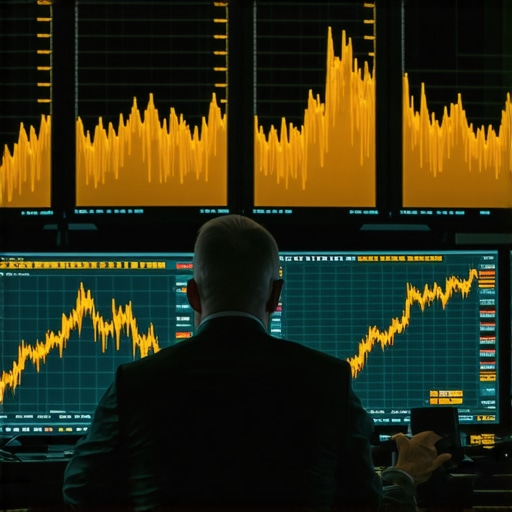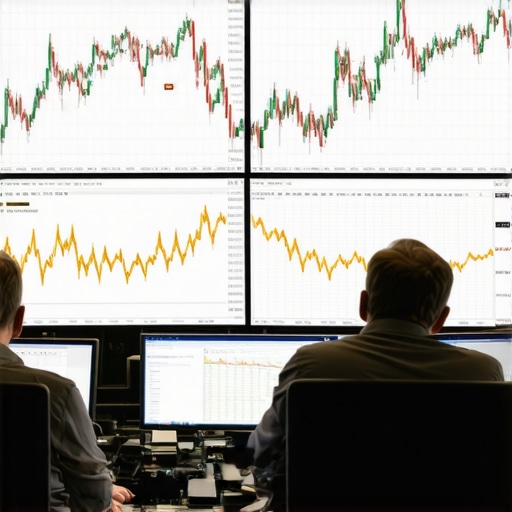Unlocking the Secrets of Gold Trading for Maximum Profitability
Gold trading has become increasingly popular among investors seeking to capitalize on the precious metal’s price fluctuations. As a versatile asset, gold can serve not only as a hedge against inflation but also as a means to generate profits in the financial markets. In this article, we’ll explore proven gold trading techniques that can help investors maximize their returns while minimizing risks.
Understanding Gold Trading Fundamentals
Before diving into specific techniques, it’s essential to grasp the fundamentals of gold trading. The gold market operates through various channels, including physical gold, futures contracts, and gold exchange-traded funds (ETFs). Each of these avenues offers unique advantages and risks. For instance, physical gold is tangible and can provide a sense of security, while gold futures allow traders to speculate on price movements without needing to own the asset physically.
Investors can further explore the differences between gold bars and coins to determine which might best suit their investment strategy. Additionally, understanding market dynamics, including supply and demand, is vital for effective trading.
Key Techniques for Gold Trading Success
Implementing specific strategies can significantly enhance your gold trading success. Here are some proven techniques:
1. Technical Analysis for Price Prediction
Technical analysis is a critical tool for gold traders. By analyzing historical price charts, traders can identify trends and make informed predictions about future movements. This technique involves using various indicators such as moving averages, Bollinger Bands, and the Relative Strength Index (RSI) to gauge market sentiment. By mastering technical analysis, traders can develop a clearer picture of when to enter and exit trades.
For newcomers, resources like understanding the basics of trading can provide a solid foundation.
2. Stay Informed about Market Influences
The gold market is influenced by numerous factors, including geopolitical events, economic indicators, and central bank policies. Staying informed about these elements can help traders anticipate price movements. For example, when geopolitical tensions rise, gold often experiences a surge in demand, pushing prices higher. Understanding how these influences affect market dynamics is crucial for making timely trading decisions.
3. Diversification of Gold Investments
Diversifying your gold investments can mitigate risks associated with volatility in the market. Instead of putting all your capital into one type of gold asset, consider spreading your investments across physical gold, gold ETFs, and gold mining stocks. This strategy can help balance your portfolio and provide steady returns regardless of market fluctuations.
For further insights on diversification, you might find our post on the role of gold in portfolio diversification particularly useful.
4. Employing Risk Management Techniques
Effective risk management is essential for successful trading. Setting stop-loss orders can protect your investments from significant losses. By determining a price point at which you will exit a losing trade, you can limit potential losses while allowing profitable trades to run. Additionally, adjusting position sizes according to your risk tolerance can help manage exposure to market volatility.
Implementing these techniques will not only enhance your trading skills but also build your confidence as you navigate the gold market. As you become more proficient, consider exploring advanced strategies, such as maximizing profits with advanced trading techniques.
5. Understanding Gold Futures and Their Impact on Trading Strategies
Gold futures are contracts to buy or sell gold at a predetermined price on a specified future date. They are a powerful tool for traders looking to capitalize on price movements without the need to physically own gold. Understanding the mechanics of gold futures can enhance your trading strategies significantly. For instance, traders can use futures to hedge against price fluctuations or speculate on market trends. To dive deeper into gold futures, check out our understanding gold futures article.
6. The Role of Gold ETFs in Diversified Trading Strategies
Gold exchange-traded funds (ETFs) provide an accessible way to invest in gold without the complexities of physical ownership. These funds track the price of gold and can be traded like stocks, making them an excellent option for investors seeking flexibility and liquidity. Incorporating gold ETFs into your portfolio can help diversify your investments and reduce risk. For a beginner’s perspective on gold ETFs, refer to our guide on understanding gold ETFs.
7. Analyzing Economic Indicators That Influence Gold Prices
Gold prices are often influenced by various economic indicators, including inflation rates, interest rates, and employment data. Monitoring these indicators can provide insight into potential price movements. For example, rising inflation typically leads to higher gold demand as investors seek a hedge against currency devaluation. Understanding these correlations can refine your trading strategies. For a more in-depth analysis of factors affecting gold prices, visit our article on key factors impacting gold prices.
8. Timing the Market: When to Buy and Sell Gold
Timing is crucial in gold trading. Knowing when to enter or exit a trade can significantly impact profitability. Strategies often involve analyzing market trends, seasonal patterns, and global events. For instance, many traders recommend buying gold during periods of economic uncertainty, as prices tend to rise during such times. For tips on determining the best time to buy gold, check out our post on determining the best time to buy gold.
9. Utilizing Sentiment Analysis in Trading Gold
Sentiment analysis involves gauging market sentiment through news, social media, and trader behavior. Understanding how other traders feel about gold can provide insights into potential price movements. For instance, if negative news about the economy leads to increased buying activity in gold, this may indicate rising prices ahead. Incorporating sentiment analysis into your trading strategy can enhance your decision-making process.
10. Continuous Education and Adaptation to Market Changes
The gold market is dynamic and can be influenced by rapid changes in global economics, technology, and investor behavior. Therefore, continuous education is vital for traders seeking long-term success. Stay updated on market trends, emerging technologies, and new trading strategies. Our comprehensive guide on investing in gold offers valuable insights for new and seasoned traders alike.
11. Exploring Gold Mining Stocks for Investment Potential
Investing in gold mining stocks can be an excellent way to gain exposure to the gold market without directly trading the metal itself. Mining companies can benefit from rising gold prices, as their profit margins often increase when gold becomes more expensive. However, it’s essential to analyze the financial health of these companies, including their production costs, management effectiveness, and geopolitical risks associated with their operations. For a deeper understanding of this investment avenue, our guide on comparing gold stocks and mutual funds can provide valuable insights.
12. The Importance of Market Sentiment Analysis
Market sentiment plays a significant role in influencing gold prices. Traders should monitor news headlines, economic reports, and social media trends to gauge the overall mood of the market. A bullish sentiment can lead to increased buying pressure, while bearish sentiment might drive prices down. Utilizing sentiment analysis can help traders make informed decisions. For instance, if investors are optimistic about economic recovery, it may lead to lower gold demand as people shift towards riskier assets. Understanding these dynamics can enhance your trading strategy.
13. Utilizing Hedging Strategies for Risk Management
Hedging is a strategy employed by traders to protect their investments from adverse price movements. In the context of gold trading, this can involve using options and futures contracts to lock in prices or mitigate losses. For example, if you hold a long position in gold and anticipate potential price declines, you could buy put options to protect against losses. Learning about hedging techniques can be beneficial for those looking to safeguard their portfolios. For further reading on this topic, refer to our article on navigating gold futures.
14. The Role of Central Banks in Gold Prices
Central banks around the world hold significant quantities of gold as part of their foreign reserves. Their buying and selling activities can heavily influence gold prices. For instance, when central banks increase their gold reserves, it often indicates a lack of confidence in fiat currencies, leading to increased demand for gold. Understanding the policies and actions of central banks is crucial for traders as it can provide insights into future price trends. Our post on how central bank gold purchases affect prices delves into this aspect.
15. Keeping an Eye on Geopolitical Events
Geopolitical tensions can significantly impact gold prices, often leading to increased demand as investors seek safe-haven assets. Events such as conflicts, elections, and trade negotiations can create volatility in the markets. Traders should stay informed about current events and analyze how they might affect gold prices. For instance, during times of crisis, gold often sees a surge in demand as a reliable store of value. To better understand these influences, our article on analyzing the impact of geopolitics on gold prices is a helpful resource.
16. Leveraging Technology in Gold Trading
With the rise of technology in trading, investors now have access to various tools and platforms that can enhance their gold trading strategies. From advanced charting software to automated trading systems, leveraging technology can improve decision-making and execution. Familiarizing yourself with these tools can provide you with a competitive edge in the fast-paced gold market. For more insights on utilizing technology in trading, explore our guide on gold trading techniques.
17. The Importance of Continuous Market Analysis
In the ever-evolving landscape of gold trading, continuous market analysis is paramount. Regularly assessing market trends and price movements enables traders to make informed decisions. Tools such as market reports and analytical software can provide insights into current trends. For traders seeking to enhance their analysis skills, resources on analyzing trends in the gold market can be invaluable.
18. Understanding Gold Demand and Supply Dynamics
The interplay between supply and demand significantly influences gold prices. Factors such as mining output, jewelry demand, and central bank purchases can create fluctuations in the market. By understanding these dynamics, traders can anticipate potential price changes. Exploring articles on gold demand trends can provide deeper insights into how these factors impact trading strategies.
19. Utilizing Advanced Trading Tools
With the proliferation of trading technology, various advanced tools are now available to traders. From algorithmic trading systems to sophisticated charting applications, these tools can enhance trading efficiency and accuracy. Traders should consider integrating such technology into their strategies. For an overview of beneficial trading techniques, check out gold trading techniques that leverage technology for optimal results.
20. Exploring Gold-Backed Securities
Gold-backed securities offer an alternative avenue for investing in gold. These financial instruments are tied to the price of gold, providing investors with exposure to fluctuations without the need to hold physical gold. Understanding how these securities function can expand your investment options. For detailed insights, visit our article on gold price forecasts and their implications for gold-backed investments.
21. The Role of Inflation in Gold Investment Strategies
Inflation can significantly impact gold prices, often driving them higher as investors seek to preserve wealth. Recognizing the relationship between inflation rates and gold can inform your trading strategies. For a comprehensive understanding of how inflation influences gold, our post on gold as a hedge against inflation provides essential insights for investors.
22. Final Thoughts on Gold Trading Strategies
In conclusion, successful gold trading hinges on a combination of effective strategies, continuous learning, and market awareness. By understanding the various elements that influence gold prices and employing sophisticated trading techniques, investors can enhance their potential for profitability. Stay informed, adapt to market changes, and utilize the resources available on our site to maximize your gold trading success in 2025 and beyond.
Unlocking the Secrets of Gold Trading for Maximum Profitability
Gold trading has become increasingly popular among investors seeking to capitalize on the precious metal’s price fluctuations. As a versatile asset, gold can serve not only as a hedge against inflation but also as a means to generate profits in the financial markets. In this article, we’ll explore proven gold trading techniques that can help investors maximize their returns while minimizing risks.
Understanding Gold Trading Fundamentals
Before diving into specific techniques, it’s essential to grasp the fundamentals of gold trading. The gold market operates through various channels, including physical gold, futures contracts, and gold exchange-traded funds (ETFs). Each of these avenues offers unique advantages and risks. For instance, physical gold is tangible and can provide a sense of security, while gold futures allow traders to speculate on price movements without needing to own the asset physically.
Investors can further explore the differences between gold bars and coins to determine which might best suit their investment strategy. Additionally, understanding market dynamics, including supply and demand, is vital for effective trading.
Key Techniques for Gold Trading Success
Implementing specific strategies can significantly enhance your gold trading success. Here are some proven techniques:
1. Technical Analysis for Price Prediction
Technical analysis is a critical tool for gold traders. By analyzing historical price charts, traders can identify trends and make informed predictions about future movements. This technique involves using various indicators such as moving averages, Bollinger Bands, and the Relative Strength Index (RSI) to gauge market sentiment. By mastering technical analysis, traders can develop a clearer picture of when to enter and exit trades.
For newcomers, resources like understanding the basics of trading can provide a solid foundation.
2. Stay Informed about Market Influences
The gold market is influenced by numerous factors, including geopolitical events, economic indicators, and central bank policies. Staying informed about these elements can help traders anticipate price movements. For example, when geopolitical tensions rise, gold often experiences a surge in demand, pushing prices higher. Understanding how these influences affect market dynamics is crucial for making timely trading decisions.
3. Diversification of Gold Investments
Diversifying your gold investments can mitigate risks associated with volatility in the market. Instead of putting all your capital into one type of gold asset, consider spreading your investments across physical gold, gold ETFs, and gold mining stocks. This strategy can help balance your portfolio and provide steady returns regardless of market fluctuations.
For further insights on diversification, you might find our post on the role of gold in portfolio diversification particularly useful.
4. Employing Risk Management Techniques
Effective risk management is essential for successful trading. Setting stop-loss orders can protect your investments from significant losses. By determining a price point at which you will exit a losing trade, you can limit potential losses while allowing profitable trades to run. Additionally, adjusting position sizes according to your risk tolerance can help manage exposure to market volatility.
Implementing these techniques will not only enhance your trading skills but also build your confidence as you navigate the gold market. As you become more proficient, consider exploring advanced strategies, such as maximizing profits with advanced trading techniques.
5. Understanding Gold Futures and Their Impact on Trading Strategies
Gold futures are contracts to buy or sell gold at a predetermined price on a specified future date. They are a powerful tool for traders looking to capitalize on price movements without the need to physically own gold. Understanding the mechanics of gold futures can enhance your trading strategies significantly. For instance, traders can use futures to hedge against price fluctuations or speculate on market trends. To dive deeper into gold futures, check out our understanding gold futures article.
6. The Role of Gold ETFs in Diversified Trading Strategies
Gold exchange-traded funds (ETFs) provide an accessible way to invest in gold without the complexities of physical ownership. These funds track the price of gold and can be traded like stocks, making them an excellent option for investors seeking flexibility and liquidity. Incorporating gold ETFs into your portfolio can help diversify your investments and reduce risk. For a beginner’s perspective on gold ETFs, refer to our guide on understanding gold ETFs.
7. Analyzing Economic Indicators That Influence Gold Prices
Gold prices are often influenced by various economic indicators, including inflation rates, interest rates, and employment data. Monitoring these indicators can provide insight into potential price movements. For example, rising inflation typically leads to higher gold demand as investors seek a hedge against currency devaluation. Understanding these correlations can refine your trading strategies. For a more in-depth analysis of factors affecting gold prices, visit our article on key factors impacting gold prices.
8. Timing the Market: When to Buy and Sell Gold
Timing is crucial in gold trading. Knowing when to enter or exit a trade can significantly impact profitability. Strategies often involve analyzing market trends, seasonal patterns, and global events. For instance, many traders recommend buying gold during periods of economic uncertainty, as prices tend to rise during such times. For tips on determining the best time to buy gold, check out our post on determining the best time to buy gold.
9. Utilizing Sentiment Analysis in Trading Gold
Sentiment analysis involves gauging market sentiment through news, social media, and trader behavior. Understanding how other traders feel about gold can provide insights into potential price movements. For instance, if negative news about the economy leads to increased buying activity in gold, this may indicate rising prices ahead. Incorporating sentiment analysis into your trading strategy can enhance your decision-making process.
10. Continuous Education and Adaptation to Market Changes
The gold market is dynamic and can be influenced by rapid changes in global economics, technology, and investor behavior. Therefore, continuous education is vital for traders seeking long-term success. Stay updated on market trends, emerging technologies, and new trading strategies. Our comprehensive guide on investing in gold offers valuable insights for new and seasoned traders alike.
11. Exploring Gold Mining Stocks for Investment Potential
Investing in gold mining stocks can be an excellent way to gain exposure to the gold market without directly trading the metal itself. Mining companies can benefit from rising gold prices, as their profit margins often increase when gold becomes more expensive. However, it’s essential to analyze the financial health of these companies, including their production costs, management effectiveness, and geopolitical risks associated with their operations. For a deeper understanding of this investment avenue, our guide on comparing gold stocks and mutual funds can provide valuable insights.
12. The Importance of Market Sentiment Analysis
Market sentiment plays a significant role in influencing gold prices. Traders should monitor news headlines, economic reports, and social media trends to gauge the overall mood of the market. A bullish sentiment can lead to increased buying pressure, while bearish sentiment might drive prices down. Utilizing sentiment analysis can help traders make informed decisions. For instance, if investors are optimistic about economic recovery, it may lead to lower gold demand as people shift towards riskier assets. Understanding these dynamics can enhance your trading strategy.
13. Utilizing Hedging Strategies for Risk Management
Hedging is a strategy employed by traders to protect their investments from adverse price movements. In the context of gold trading, this can involve using options and futures contracts to lock in prices or mitigate losses. For example, if you hold a long position in gold and anticipate potential price declines, you could buy put options to protect against losses. Learning about hedging techniques can be beneficial for those looking to safeguard their portfolios. For further reading on this topic, refer to our article on navigating gold futures.
14. The Role of Central Banks in Gold Prices
Central banks around the world hold significant quantities of gold as part of their foreign reserves. Their buying and selling activities can heavily influence gold prices. For instance, when central banks increase their gold reserves, it often indicates a lack of confidence in fiat currencies, leading to increased demand for gold. Understanding the policies and actions of central banks is crucial for traders as it can provide insights into future price trends. Our post on how central bank gold purchases affect prices delves into this aspect.
15. Keeping an Eye on Geopolitical Events
Geopolitical tensions can significantly impact gold prices, often leading to increased demand as investors seek safe-haven assets. Events such as conflicts, elections, and trade negotiations can create volatility in the markets. Traders should stay informed about current events and analyze how they might affect gold prices. For instance, during times of crisis, gold often sees a surge in demand as a reliable store of value. To better understand these influences, our article on analyzing the impact of geopolitics on gold prices is a helpful resource.
16. Leveraging Technology in Gold Trading
With the rise of technology in trading, investors now have access to various tools and platforms that can enhance their gold trading strategies. From advanced charting software to automated trading systems, leveraging technology can improve decision-making and execution. Familiarizing yourself with these tools can provide you with a competitive edge in the fast-paced gold market. For more insights on utilizing technology in trading, explore our guide on gold trading techniques.
17. The Importance of Continuous Market Analysis
In the ever-evolving landscape of gold trading, continuous market analysis is paramount. Regularly assessing market trends and price movements enables traders to make informed decisions. Tools such as market reports and analytical software can provide insights into current trends. For traders seeking to enhance their analysis skills, resources on analyzing trends in the gold market can be invaluable.
18. Understanding Gold Demand and Supply Dynamics
The interplay between supply and demand significantly influences gold prices. Factors such as mining output, jewelry demand, and central bank purchases can create fluctuations in the market. By understanding these dynamics, traders can anticipate potential price changes. Exploring articles on gold demand trends can provide deeper insights into how these factors impact trading strategies.
19. Utilizing Advanced Trading Tools
With the proliferation of trading technology, various advanced tools are now available to traders. From algorithmic trading systems to sophisticated charting applications, these tools can enhance trading efficiency and accuracy. Traders should consider integrating such technology into their strategies. For an overview of beneficial trading techniques, check out gold trading techniques that leverage technology for optimal results.
20. Exploring Gold-Backed Securities
Gold-backed securities offer an alternative avenue for investing in gold. These financial instruments are tied to the price of gold, providing investors with exposure to fluctuations without the need to hold physical gold. Understanding how these securities function can expand your investment options. For detailed insights, visit our article on gold price forecasts and their implications for gold-backed investments.
21. The Role of Inflation in Gold Investment Strategies
Inflation can significantly impact gold prices, often driving them higher as investors seek to preserve wealth. Recognizing the relationship between inflation rates and gold can inform your trading strategies. For a comprehensive understanding of how inflation influences gold, our post on gold as a hedge against inflation provides essential insights for investors.
22. Final Thoughts on Gold Trading Strategies
In conclusion, successful gold trading hinges on a combination of effective strategies, continuous learning, and market awareness. By understanding the various elements that influence gold prices and employing sophisticated trading techniques, investors can enhance their potential for profitability. Stay informed, adapt to market changes, and utilize the resources available on our site to maximize your gold trading success in 2025 and beyond.
Frequently Asked Questions (FAQs) About Gold Trading
1. What are the best strategies for gold trading?
The best strategies for gold trading include technical analysis, staying informed about market influences, diversification of investments, and employing risk management techniques.
2. How can I start trading gold?
To start trading gold, you can open an account with a brokerage that offers gold trading options, conduct thorough research on market conditions, and develop your trading strategy.
3. What role do economic indicators play in gold trading?
Economic indicators such as inflation rates, interest rates, and employment data can significantly influence gold prices. Understanding these factors can help traders make informed decisions.
4. How does geopolitical instability affect gold prices?
Geopolitical instability often leads to increased demand for gold as a safe-haven asset, driving prices higher during times of crisis.
5. What is the significance of gold ETFs?
Gold ETFs provide an accessible way for investors to gain exposure to gold without the complexities of physical ownership, allowing for liquidity and flexibility in trading.
6. How often should I analyze the gold market?
Continuous analysis is essential; traders should regularly assess market trends, price movements, and economic indicators to stay informed and make timely decisions.
7. Can I trade gold futures without owning physical gold?
Yes, trading gold futures allows investors to speculate on gold prices without physically owning the metal, making it a popular choice among traders.
8. What are the risks of trading gold?
Risks of trading gold include market volatility, geopolitical factors, and economic changes that can impact prices. Effective risk management strategies can help mitigate these risks.
9. How do I choose between physical gold and gold-backed securities?
Choosing between physical gold and gold-backed securities depends on your investment goals, risk tolerance, and preference for direct ownership versus financial instruments tied to gold prices.
10. Why is education important for gold traders?
Continuous education helps traders understand market dynamics, refine their strategies, and adapt to changes in the gold market, ultimately enhancing their trading success.
Authority Resources for Gold Trading
For further information and resources on gold trading, consider the following trusted websites and literature:










The section on diversification really resonated with me. I’ve found that putting all my funds into just physical gold stocks made me vulnerable to market swings that I hadn’t fully anticipated. Shifting my portfolio to include a mix of gold ETFs and even some gold mining stocks has helped me smooth out volatility and has provided steady returns even when bullion prices get a bit unpredictable. However, I’m still developing my risk management skills, especially when it comes to setting effective stop-loss levels on futures contracts. The article’s pointers on using stop-loss orders and position sizing to manage exposure seem like a practical approach I should start applying more diligently. I’d be interested to hear how others balance the sometimes competing priorities of risk management and profit maximization in their gold trading strategies. How do you adjust your positions during periods of heightened geopolitical uncertainty or economic shifts without compromising on growth potential?
This article provides a thorough overview of the key techniques for maximizing profitability in gold trading, and I particularly appreciate the emphasis on understanding market fundamentals like futures and ETFs. I’ve personally found that combining technical analysis with staying informed about geopolitical events offers a balanced approach to timing trades. For instance, when global tensions escalate, gold tends to rally, and being aware of these patterns helped me shift my portfolio to more defensive positions early on. The challenge I face is how to balance risk management—like setting stop-loss orders—while still allowing room for growth during volatile periods. Have others found effective methods for adjusting their positions without overly restricting potential gains? Also, I’d love to hear about tools or software that people trust for technical analysis—I’ve been exploring a few but would like recommendations. Overall, continuous education and market awareness seem vital for sustained success in today’s dynamic gold market.